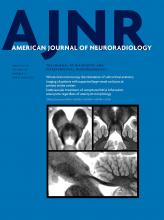Index by author
Li, B.
- Head and Neck ImagingYou have accessCT Texture Analysis of Cervical Lymph Nodes on Contrast-Enhanced [18F] FDG-PET/CT Images to Differentiate Nodal Metastases from Reactive Lymphadenopathy in HIV-Positive Patients with Head and Neck Squamous Cell CarcinomaH. Kuno, N. Garg, M.M. Qureshi, M.N. Chapman, B. Li, S.K. Meibom, M.T. Truong, K. Takumi and O. SakaiAmerican Journal of Neuroradiology March 2019, 40 (3) 543-550; DOI: https://doi.org/10.3174/ajnr.A5974
Li, J.
- FELLOWS' JOURNAL CLUBAdult BrainOpen AccessAccurate Patient-Specific Machine Learning Models of Glioblastoma Invasion Using Transfer LearningL.S. Hu, H. Yoon, J.M. Eschbacher, L.C. Baxter, A.C. Dueck, A. Nespodzany, K.A. Smith, P. Nakaji, Y. Xu, L. Wang, J.P. Karis, A.J. Hawkins-Daarud, K.W. Singleton, P.R. Jackson, B.J. Anderies, B.R. Bendok, R.S. Zimmerman, C. Quarles, A.B. Porter-Umphrey, M.M. Mrugala, A. Sharma, J.M. Hoxworth, M.G. Sattur, N. Sanai, P.E. Koulemberis, C. Krishna, J.R. Mitchell, T. Wu, N.L. Tran, K.R. Swanson and J. LiAmerican Journal of Neuroradiology March 2019, 40 (3) 418-425; DOI: https://doi.org/10.3174/ajnr.A5981
The authors evaluated tumor cell density using a transfer learning method that generates individualized patient models, grounded in the wealth of population data, while also detecting and adjusting for interpatient variabilities based on each patient's own histologic data. They collected 82 image-recorded biopsy samples, from 18 patients with primary GBM. With multivariate modeling, transfer learning improved performance (r = 0.88) compared with one-model-fits-all (r = 0.39). They conclude that transfer learning significantly improves predictive modeling performance for quantifying tumor cell density in glioblastoma.
Li, J.-Y.
- Adult BrainOpen AccessLongitudinal White Matter Changes following Carbon Monoxide Poisoning: A 9-Month Follow-Up Voxelwise Diffusional Kurtosis Imaging StudyM.-C. Chou, J.-Y. Li and P.-H. LaiAmerican Journal of Neuroradiology March 2019, 40 (3) 478-482; DOI: https://doi.org/10.3174/ajnr.A5979
Li, Y.
- Adult BrainOpen AccessComplementary Roles of Dynamic Contrast-Enhanced MR Imaging and Postcontrast Vessel Wall Imaging in Detecting High-Risk Intracranial AneurysmsH. Qi, X. Liu, P. Liu, W. Yuan, A. Liu, Y. Jiang, Y. Li, J. Sun and H. ChenAmerican Journal of Neuroradiology March 2019, 40 (3) 490-496; DOI: https://doi.org/10.3174/ajnr.A5983
Limbucci, N.
- NeurointerventionYou have accessFlow-Diversion Treatment of Unruptured Saccular Anterior Communicating Artery Aneurysms: A Systematic Review and Meta-AnalysisF. Cagnazzo, N. Limbucci, S. Nappini, L. Renieri, A. Rosi, A. Laiso, D. Tiziano di Carlo, P. Perrini and S. MangiaficoAmerican Journal of Neuroradiology March 2019, 40 (3) 497-502; DOI: https://doi.org/10.3174/ajnr.A5967
Lin, C.-J.
- NeurointerventionOpen AccessValidating the Automatic Independent Component Analysis of DSAJ.-S. Hong, Y.-H. Kao, F.-C. Chang and C.-J. LinAmerican Journal of Neuroradiology March 2019, 40 (3) 540-542; DOI: https://doi.org/10.3174/ajnr.A5963
Liu, A.
- Adult BrainOpen AccessComplementary Roles of Dynamic Contrast-Enhanced MR Imaging and Postcontrast Vessel Wall Imaging in Detecting High-Risk Intracranial AneurysmsH. Qi, X. Liu, P. Liu, W. Yuan, A. Liu, Y. Jiang, Y. Li, J. Sun and H. ChenAmerican Journal of Neuroradiology March 2019, 40 (3) 490-496; DOI: https://doi.org/10.3174/ajnr.A5983
Liu, P.
- Adult BrainOpen AccessComplementary Roles of Dynamic Contrast-Enhanced MR Imaging and Postcontrast Vessel Wall Imaging in Detecting High-Risk Intracranial AneurysmsH. Qi, X. Liu, P. Liu, W. Yuan, A. Liu, Y. Jiang, Y. Li, J. Sun and H. ChenAmerican Journal of Neuroradiology March 2019, 40 (3) 490-496; DOI: https://doi.org/10.3174/ajnr.A5983
Liu, X.
- Adult BrainOpen AccessComplementary Roles of Dynamic Contrast-Enhanced MR Imaging and Postcontrast Vessel Wall Imaging in Detecting High-Risk Intracranial AneurysmsH. Qi, X. Liu, P. Liu, W. Yuan, A. Liu, Y. Jiang, Y. Li, J. Sun and H. ChenAmerican Journal of Neuroradiology March 2019, 40 (3) 490-496; DOI: https://doi.org/10.3174/ajnr.A5983
Lopes, M.-B.
- FELLOWS' JOURNAL CLUBAdult BrainYou have accessNeuroimaging-Based Classification Algorithm for Predicting 1p/19q-Codeletion Status in IDH-Mutant Lower Grade GliomasP.P. Batchala, T.J.E. Muttikkal, J.H. Donahue, J.T. Patrie, D. Schiff, C.E. Fadul, E.K. Mrachek, M.-B. Lopes, R. Jain and S.H. PatelAmerican Journal of Neuroradiology March 2019, 40 (3) 426-432; DOI: https://doi.org/10.3174/ajnr.A5957
One hundred two IDH-mutant lower grade gliomas with preoperative MR imaging and known 1p/19q status from The Cancer Genome Atlas composed a training dataset. Two neuroradiologists in consensus analyzed the training dataset for various imaging features: tumor or cyst texture, margins, cortical infiltration, T2-FLAIR mismatch, tumor cyst, T2* susceptibility, hydrocephalus, midline shift, maximum dimension, primary lobe, necrosis, enhancement, edema, and gliomatosis. Statistical analysis of the training data produced a multivariate classification model for codeletion prediction based on a subset of MR imaging features and patient age. Training dataset analysis produced a 2-step classification algorithm with 86.3% codeletion prediction accuracy, based on the following: 1) the presence of the T2-FLAIR mismatch sign, which was 100% predictive of noncodeleted lowergrade gliomas; and 2)a logistic regression model based on texture, patient age, T2* susceptibility, primary lobe, and hydrocephalus. Independent validation ofthe classification algorithm rendered codeletion prediction accuracies of 81.1% and 79.2% in 2 independent readers.








